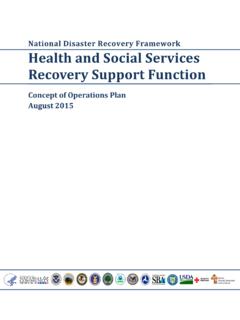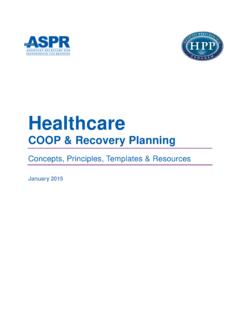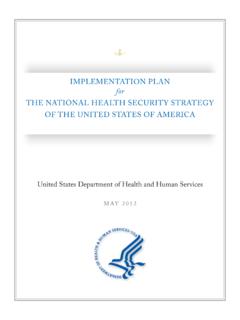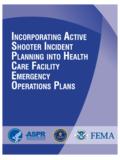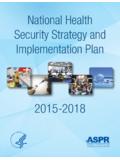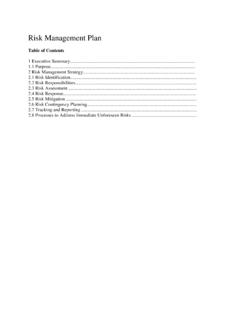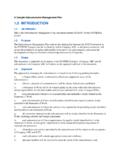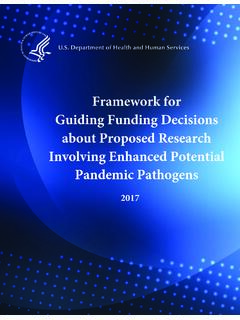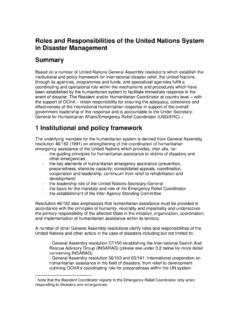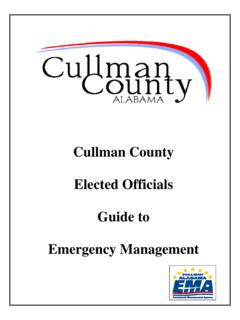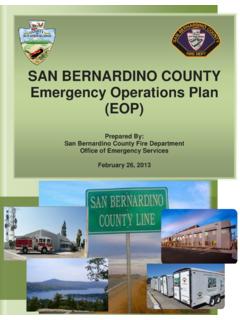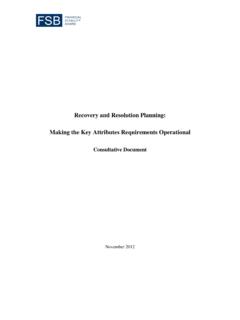Transcription of HHS/ASPR Fiscal Year 2019 Budget-in-Brief Public Health ...
1 Department of Health and Human ServicesOffice of the Assistant Secretary for preparedness and ResponseFiscal Year 2019 Budget-in-BriefPublic Health and Social Services Emergency FundThe Office of the Assistant Secretary for preparedness and Response (ASPR) was established by Congress a decade ago (in the Pandemic and All Hazards preparedness Act of 2006) to create unity of command by consolidating substantial federal Public Health and medical preparedness and response functions under the ASPR (subject to the authority of the Secretary).
2 ASPR s mission is to save lives and protect Americans from 21st century Health security threats. ASPR is the national security mission manager for HHS. On behalf of the Secretary, ASPR leads the federal Public Health and medical, preparedness , response and recovery to disasters and Public Health emergencies, in accordance with the National Response Framework. ASPR coordinates the nation s medical and Public Health capabilities to help Americans during emergencies and disasters, whatever their works to enhance medical surge capacity when needed during disasters by organizing, training, equipping, and deploying federal Public Health and medical personnel and providing logistical support for federal responses to Public Health emergencies.
3 ASPR improves readiness and preparedness at the state and local levels by administering grants to enhance the capacity and capability of the nation s healthcare infrastructure to respond to disasters and by carrying out drills and operational exercises. ASPR also oversees advanced research, development, procurement and stockpiling of medical countermeasures ( , vaccines, medicines, diagnostics, and other necessary medical supplies) against biological, chemical, radiological and nuclear agents and pandemic or epidemic FY 2019 President s Budget Request for ASPR is $ billion, an increase of $722 million above the FY 2018 Annualized Continuing resolution level.
4 This funding level reflects the transfer of the Strategic National Stockpile (SNS) from the Centers for Disease Control and Prevention to ASPR, supports emergency operations planning and response, and maintains critical investments in medical countermeasures (MCMs). The request provides: $ billion for ASPR s Biomedical Advanced Research and Development Authority (BARDA) including: $512 million to support the advanced development of the highest priority MCMs, which includes $192 million to combat antimicrobial resistant bacteria (CARB), $260 million to support Advanced Research and Development (ARD), and $60 million for BARDA operations.
5 $245 million for diagnostic tools, vaccines, immunotherapeutics, and international preparedness for pandemic influenza ( PI ) and emerging infectious diseases, and $510 million for Project BioShield (PBS) to support late-stage development and procurement of MCMs for national security threats. $575 million for the SNS. $ million for the Hospital preparedness Program (HPP) to support cooperative agreements with state, local, and territorial Health departments to improve healthcare delivery surge capacity and enhance regional emergency preparedness and response coordination through healthcare coalitions.
6 $ million for federal preparedness and Emergency Operations, the National Disaster Medical System (NDMS), and the Civilian Volunteer Medical Reserve Corps (MRC). $46 million for Health security policy, strategic planning, and ASPR accomplish its mission, ASPR has four priority pillars: 1) enhancing the MCM enterprise; 2) building a regional disaster Health response system; 3) sustaining Public Health security capacity; and, 4) providing strong leadership. Fiscal Year 2019 Budget-In-BriefPillar #1 Enhancing the Medical Countermeasures EnterpriseASPR s first priority pillar is developing, stockpiling, and using innovative vaccines, medicines, and supplies to protect Americans against 21st century MCMs Against 21st Century Threats $ billion: The FY 2019 Budget for BARDA provides a $145 million increase above the FY 2018 Annualized Continuing resolution level.
7 BARDA s mission is to develop and make available MCMs that address some of our most serious national threats including chemical, biological, radiological, and nuclear (CBRN) threats, pandemic influenza, and emerging/re-emerging infectious diseases. BARDA accomplishes their mission through a combination of programs including ARD, PBS, and 2017, major milestones reached in MCM development included: The first BARDA supported antibacterial drug received approval from the Food and Drug Administration (FDA); The first BARDA supported smallpox treatment applied for FDA approval.
8 And The first BARDA-led portfolio partnerships formed to fight pandemic influenza and emerging infectious BARDA portfolio includes 34 FDA approvals of 30 unique products addressing CBRN, PI, and Emerging Infectious Disease threats. Under PBS, 27 MCMs have been supported for late-stage development and procurement to address a wide range of threats, such as Ebola, anthrax, smallpox, botulism, viral hemorrhagic fever, as well as chemical, radiological and nuclear threats. Of the 27 products, 14 have been delivered to the SNS, and six have achieved FDA $ million: The budget request for ARD is an increase of $ million above the FY 2018 Annualized Continuing resolution level.
9 These resources support the advanced development of high priority MCMs. ARD funding supports development of MCMs to address a wide range of primary and secondary effects of exposures to various threat agents and treatments for injuries caused by radiation, nuclear, thermal bums, viral hemorrhagic fever, and chemical BARDA s ARD program, funds are dedicated to the CARB-X program via novel Public -private partnerships. CARB-X is a collaborative program that identifies, builds, and manages a portfolio of antibacterial MCMs, and promotes innovations in antibacterial drugs, vaccines, and diagnostics.
10 As of late 2017, CARB-X had made awards to 22 different companies and is currently investing in ten non-traditional approaches to treating bacterial infections, nine new classes of antibiotics, and four next-generation antibiotics to overcome known resistance $510 million: The budget request for PBS is an increase of $ million above the FY 2018 Annualized Continuing resolution level. The Administration proposes advanced appropriation and no-year funds. This would align with the original Special Reserve Funds that was established under PBS to serve as a market guarantee to entice developers to support the unique requirements for products that have little to no commercial market.
